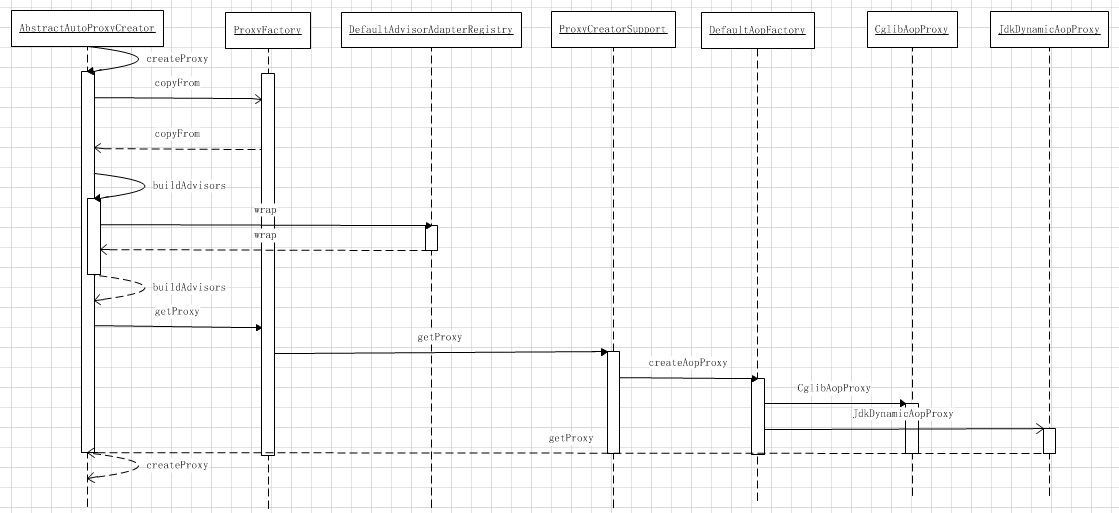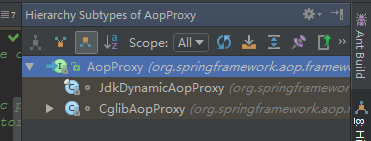from:https://my.oschina.net/kaywu123/blog/638181
创建代理
代理的定义其实非常简单,就是改变原来目标对象方法调用的运行轨迹。这种改变,首先会对这些方法进行拦截,从而为这些方法提供工作空间,随后在进行回调,从而完成 AOP 切面实现的一整个逻辑。
而创建代理是 Spring AOP 功能实现最核心的地方,一般而言 Spring AOP 动态生成代理有两种方法:JDK 和 CGLIB。下面是具体时序图:

通过时序图的分析我们知道她主要是由 AbstractAutoProxyCreator 类和 ProxyFactory 工厂类来完成的。下面我们进行分析。
初始化操作
创建代理工厂
在获取了所有对应 bean 的增强器后,便可以进行代理的创建了。
AbstractAutoProxyCreator.java
protected Object createProxy(
Class<?> beanClass, String beanName, Object[] specificInterceptors, TargetSource targetSource) {
ProxyFactory proxyFactory = new ProxyFactory();
// 获取当前类中相关属性
proxyFactory.copyFrom(this);
// 决定对给定的 bean 是否应该使用 targetClass 而不是他的接口代理,
// 检查 proxyTargeClass 设置以及 preserveTargetClass 属性
if (!proxyFactory.isProxyTargetClass()) {
if (shouldProxyTargetClass(beanClass, beanName)) {
proxyFactory.setProxyTargetClass(true);
}
else {
evaluateProxyInterfaces(beanClass, proxyFactory);
}
}
Advisor[] advisors = buildAdvisors(beanName, specificInterceptors);
for (Advisor advisor : advisors) {
// 加入增强器
proxyFactory.addAdvisor(advisor);
}
// 设置要代理的类
proxyFactory.setTargetSource(targetSource);
// 定制代理
customizeProxyFactory(proxyFactory);
// 用来控制代理过程被配置之后,是否还允许修改通知。
// 缺省值为 false (即在代理被配置之后,不允许修改代理的配置)
proxyFactory.setFrozen(this.freezeProxy);
if (advisorsPreFiltered()) {
proxyFactory.setPreFiltered(true);
}
return proxyFactory.getProxy(getProxyClassLoader());
}对于代理类的创建及处理,Spring 委托给了 ProxyFactory 去处理,而在此函数中主要是对 ProxyFactory 的初始化操作,进而对真正的创建代理做准备,这些初始化操作包括6个内容:(1)获取当前类中的属性。(2)添加代理接口。(3)封装 Advisor 并加入到 ProxyFactory 中。(4)设置要代理的类。(5)当然在 Spring 中还为子类提供了定制的函数 customizeProxyFactory,子类可以在此函数中对 ProxyFactory 的进一步封装。(6)进行获取代理操作。
封装逻辑
其中,封装 Advisor 并加入到 ProxyFactory 中以及创建代理是最为繁琐的两个过程,可以通过 ProxyFactory 提供 addAdvisor 方法直接将通知器置如代理创建工厂中,但是将拦截器封装为通知器还是需要一定逻辑的。
AbstractAutoProxyCreator.java
protected Advisor[] buildAdvisors(String beanName, Object[] specificInterceptors) {
// 解析注册的所有 interceptorName
Advisor[] commonInterceptors = resolveInterceptorNames();
List<Object> allInterceptors = new ArrayList<Object>();
if (specificInterceptors != null) {
// 加入拦截器
allInterceptors.addAll(Arrays.asList(specificInterceptors));
if (commonInterceptors != null) {
if (this.applyCommonInterceptorsFirst) {
allInterceptors.addAll(0, Arrays.asList(commonInterceptors));
}
else {
allInterceptors.addAll(Arrays.asList(commonInterceptors));
}
}
}
if (logger.isDebugEnabled()) {
int nrOfCommonInterceptors = (commonInterceptors != null ? commonInterceptors.length : 0);
int nrOfSpecificInterceptors = (specificInterceptors != null ? specificInterceptors.length : 0);
logger.debug("Creating implicit proxy for bean '" + beanName + "' with " + nrOfCommonInterceptors +
" common interceptors and " + nrOfSpecificInterceptors + " specific interceptors");
}
Advisor[] advisors = new Advisor[allInterceptors.size()];
for (int i = 0; i < allInterceptors.size(); i++) {
// 拦截器进行封装转化为 Advisor
advisors[i] = this.advisorAdapterRegistry.wrap(allInterceptors.get(i));
}
return advisors;
}DefaultAdvisorAdapterRegistry.java
@Override
public Advisor wrap(Object adviceObject) throws UnknownAdviceTypeException {
// 如果要封装的对象本身就是 Advisor 类型的那么无需再做过多处理
if (adviceObject instanceof Advisor) {
return (Advisor) adviceObject;
}
// 因为此封装方法只对 Advisor 与 Advice 两种类型的数据有效
if (!(adviceObject instanceof Advice)) {
throw new UnknownAdviceTypeException(adviceObject);
}
Advice advice = (Advice) adviceObject;
if (advice instanceof MethodInterceptor) {
// 如果是 MethodInterceptor 类型则使用 DefaultPointcutAdvisor 封装
return new DefaultPointcutAdvisor(advice);
}
// 如果存在 Advisor 的适配器那么也需要进行封装
for (AdvisorAdapter adapter : this.adapters) {
// Check that it is supported.
if (adapter.supportsAdvice(advice)) {
return new DefaultPointcutAdvisor(advice);
}
}
throw new UnknownAdviceTypeException(advice);
}由于 Spring 中涉及过多的拦截器、通知器、增强方法等方式来对逻辑进行增强,所以非常有必要统一封装成 Advisor 来进行代理的创建,完成了增强的封装过程,那么解析最重要的一步就是代理的创建与获取了。
AspectJProxyFactory.java
public <T> T getProxy(ClassLoader classLoader) {
return (T) createAopProxy().getProxy(classLoader);
}代理生成
创建代理
我们接着上面的例子继续进行分析。
ProxyCreatorSupport.java
protected final synchronized AopProxy createAopProxy() {
if (!this.active) {
activate();
}
// 创建代理
return getAopProxyFactory().createAopProxy(this);
}createAopProxy 方法封装在 AopProxyFactory 接口中,通过对接口继承关系的跟踪,最终在 DefaultAopFactory中找到了其实现方法。

DefaultAopFactory.java
@Override
public AopProxy createAopProxy(AdvisedSupport config) throws AopConfigException {
// 这里判断是使用 JDKProxy 的实现或者 CGLIBProxy 的实现
if (config.isOptimize() || config.isProxyTargetClass() || hasNoUserSuppliedProxyInterfaces(config)) {
Class<?> targetClass = config.getTargetClass();
if (targetClass == null) {
throw new AopConfigException("TargetSource cannot determine target class: " +
"Either an interface or a target is required for proxy creation.");
}
if (targetClass.isInterface()) {
return new JdkDynamicAopProxy(config);
}
return new ObjenesisCglibAopProxy(config);
}
else {
return new JdkDynamicAopProxy(config);
}
}到此已经完成了代理创建。而源码中提到的 JDK 动态代理 和 CGLIB 字节码生成代理笔者会在随后进行介绍,这里需要注意的是if中的三个判断条件:(1)optimize:用来控制通过CGLIB创建的代理是否使用激进的优化策略。除非完全了解AOP。否则不推荐。目前这个属性也仅仅用于 CGLIB。(2)proxyTargetClass:这个属性为 true 时,目标类本身本代理而不是目标类的接口。如果这个属性值被设为 true,CGLIB 代理将被创建,设置方式:<aop:aspectj-autoproxy proxy-target-class="true"/>。(3)hasNoUserSuppliedProxyInterfaces:是否存在代理接口。
创建代理的方法
Spring AOP 内动态生成代理有两种方法:JDK 和 CGLIB。一般情况下,如果目标对象实现了接口,默认情况下会采用 JDK 动态代理实现 AOP。如果目标对象实现了接口,可以强制使用 CGLIB 实现 AOP。如果目标对象没有实现接口,必须采用 CGLIB,Spring 会自动在 JDK动态代理和 CGLIB 之间转化。而且,JDK 动态代理只能对实现了接口的类生成代理,而不能针对类。CGLIB是针对类实现代理的,但主要是对指定的类生成一个子类,覆盖其中的方法,是继承实现,所以该类或方法最好不要声明成 final。
这里需要特别注意的是 AopProxy 接口,通过上面的代码我们知道了,AopProxy 才是生成代理的主要位置。而前面看到的 ProxyFactory 在 AopProxy 代理对象和IOC容器配置之间仅仅起一个桥梁作用。AopProxy 代理对象可以由 JDK 或 CGLIB 来生成,而下面是他们的层次关系:

JDK 动态代理
在对于 JDK 代理的使用中,JDK 动态代理的实现类 JdkDynamicAopProxy,而 JdkDynamicAopProxy 类最为核心的是 InvocationHandler 接口。而在 JdkDynamicAopProxy 类的方法里较为重要的有三个:构造函数、invoke 方法和 getProxy 方法。下面我就一个个的进行分析:
JdkDynamicAopProxy.java
public JdkDynamicAopProxy(AdvisedSupport config) throws AopConfigException {
Assert.notNull(config, "AdvisedSupport must not be null");
if (config.getAdvisors().length == 0 && config.getTargetSource() == AdvisedSupport.EMPTY_TARGET_SOURCE) {
throw new AopConfigException("No advisors and no TargetSource specified");
}
this.advised = config;
}从源码我们可以看出,构造函数主要适用于传值。
JdkDynamicAopProxy.java
@Override
public Object getProxy(ClassLoader classLoader) {
if (logger.isDebugEnabled()) {
logger.debug("Creating JDK dynamic proxy: target source is " + this.advised.getTargetSource());
}
Class<?>[] proxiedInterfaces = AopProxyUtils.completeProxiedInterfaces(this.advised);
findDefinedEqualsAndHashCodeMethods(proxiedInterfaces);
return Proxy.newProxyInstance(classLoader, proxiedInterfaces, this);
}而 getProxy 方法则是用于获取生成的代理对象的,是必不可少的方法。
JdkDynamicAopProxy.java
@Override
public Object invoke(Object proxy, Method method, Object[] args) throws Throwable {
MethodInvocation invocation;
Object oldProxy = null;
boolean setProxyContext = false;
TargetSource targetSource = this.advised.targetSource;
Class<?> targetClass = null;
Object target = null;
try {
// equals 方法的处理
if (!this.equalsDefined && AopUtils.isEqualsMethod(method)) {
return equals(args[0]);
}
// hash 方法的处理
if (!this.hashCodeDefined && AopUtils.isHashCodeMethod(method)) {
return hashCode();
}
if (!this.advised.opaque && method.getDeclaringClass().isInterface() &&
method.getDeclaringClass().isAssignableFrom(Advised.class)) {
// Service invocations on ProxyConfig with the proxy config...
return AopUtils.invokeJoinpointUsingReflection(this.advised, method, args);
}
Object retVal;
// 有时候目标对象内部的自我调用将无法实施切面中的增强
// 则需要通过属性暴露代理
if (this.advised.exposeProxy) {
// Make invocation available if necessary.
oldProxy = AopContext.setCurrentProxy(proxy);
setProxyContext = true;
}
target = targetSource.getTarget();
if (target != null) {
targetClass = target.getClass();
}
// 获取当前方法的拦截器
List<Object> chain = this.advised.getInterceptorsAndDynamicInterceptionAdvice(method, targetClass);
if (chain.isEmpty()) {
// 如果没有发现任何拦截器那么直接调入切点方法
retVal = AopUtils.invokeJoinpointUsingReflection(target, method, args);
}
else {
// 将拦截器封装在 ReflectiveMethodInvocation
// 以便于使用期 proceed 进行链接表用拦截器
invocation = new ReflectiveMethodInvocation(proxy, target, method, args, targetClass, chain);
// 执行拦截器链
retVal = invocation.proceed();
}
// 返回结果
Class<?> returnType = method.getReturnType();
if (retVal != null && retVal == target && returnType.isInstance(proxy) &&
!RawTargetAccess.class.isAssignableFrom(method.getDeclaringClass())) {
retVal = proxy;
}
else if (retVal == null && returnType != Void.TYPE && returnType.isPrimitive()) {
throw new AopInvocationException(
"Null return value from advice does not match primitive return type for: " + method);
}
return retVal;
}
finally {
if (target != null && !targetSource.isStatic()) {
targetSource.releaseTarget(target);
}
if (setProxyContext) {
AopContext.setCurrentProxy(oldProxy);
}
}
}ReflectiveMethodInvocation.java
@Override
public Object proceed() throws Throwable {
// 执行完所有增强后执行切点方法
if (this.currentInterceptorIndex == this.interceptorsAndDynamicMethodMatchers.size() - 1) {
return invokeJoinpoint();
}
// 获取下一个要执行的拦截器
Object interceptorOrInterceptionAdvice =
this.interceptorsAndDynamicMethodMatchers.get(++this.currentInterceptorIndex);
if (interceptorOrInterceptionAdvice instanceof InterceptorAndDynamicMethodMatcher) {
// 动态匹配
InterceptorAndDynamicMethodMatcher dm =
(InterceptorAndDynamicMethodMatcher) interceptorOrInterceptionAdvice;
if (dm.methodMatcher.matches(this.method, this.targetClass, this.arguments)) {
return dm.interceptor.invoke(this);
}
else {
// 不匹配则不执行拦截器
return proceed();
}
}
else {
// 将 this 作为参数传递以保证档期实例中调用链的执行
return ((MethodInterceptor) interceptorOrInterceptionAdvice).invoke(this);
}
}通过源码我们知道,invoke 方法是其核心逻辑实现的地方。其主要的工作就是创建一个拦截器链,然后使用 ReflectiveMethodInvocation 类对链进行封装,最后通过 proceed 方法对拦截器进行逐个调用,而 proceed 方法负责实现方法前调用以及后置调用的逻辑处理,然后将工作委托给各个增强器,在增强器内部实现具体逻辑。
CGLIBProxy 字节码生成代理
CGLIB 是一个强大的高性能的代码生成包。Spring AOP 中完成 CGLIB 代理是托付给 CglibAopProxy 类来实现的,而也动态代理相似 getProxy 方法是这个类的主要入口。
CglibAopProxy.java
@Override
public Object getProxy(ClassLoader classLoader) {
if (logger.isDebugEnabled()) {
logger.debug("Creating CGLIB proxy: target source is " + this.advised.getTargetSource());
}
try {
Class<?> rootClass = this.advised.getTargetClass();
Assert.state(rootClass != null, "Target class must be available for creating a CGLIB proxy");
Class<?> proxySuperClass = rootClass;
if (ClassUtils.isCglibProxyClass(rootClass)) {
proxySuperClass = rootClass.getSuperclass();
Class<?>[] additionalInterfaces = rootClass.getInterfaces();
for (Class<?> additionalInterface : additionalInterfaces) {
this.advised.addInterface(additionalInterface);
}
}
// 验证 Class
validateClassIfNecessary(proxySuperClass, classLoader);
// 创建及配置 Enhancer
Enhancer enhancer = createEnhancer();
if (classLoader != null) {
enhancer.setClassLoader(classLoader);
if (classLoader instanceof SmartClassLoader &&
((SmartClassLoader) classLoader).isClassReloadable(proxySuperClass)) {
enhancer.setUseCache(false);
}
}
enhancer.setSuperclass(proxySuperClass);
enhancer.setInterfaces(AopProxyUtils.completeProxiedInterfaces(this.advised));
enhancer.setNamingPolicy(SpringNamingPolicy.INSTANCE);
enhancer.setStrategy(new UndeclaredThrowableStrategy(UndeclaredThrowableException.class));
// 设置拦截器
Callback[] callbacks = getCallbacks(rootClass);
Class<?>[] types = new Class<?>[callbacks.length];
for (int x = 0; x < types.length; x++) {
types[x] = callbacks[x].getClass();
}
// fixedInterceptorMap only populated at this point, after getCallbacks call above
enhancer.setCallbackFilter(new ProxyCallbackFilter(
this.advised.getConfigurationOnlyCopy(), this.fixedInterceptorMap, this.fixedInterceptorOffset));
enhancer.setCallbackTypes(types);
// 生成代理类以及创建代理
return createProxyClassAndInstance(enhancer, callbacks);
}
catch (CodeGenerationException ex) {
throw new AopConfigException("Could not generate CGLIB subclass of class [" +
this.advised.getTargetClass() + "]: " +
"Common causes of this problem include using a final class or a non-visible class",
ex);
}
catch (IllegalArgumentException ex) {
throw new AopConfigException("Could not generate CGLIB subclass of class [" +
this.advised.getTargetClass() + "]: " +
"Common causes of this problem include using a final class or a non-visible class",
ex);
}
catch (Exception ex) {
// TargetSource.getTarget() failed
throw new AopConfigException("Unexpected AOP exception", ex);
}
}CGLIB 的实现最重要的就是 Enhancer。以上函数完整地阐述了创建 Spring 的 Enhancer 过程,这里值得注意的是设置拦截器链 getCallbacks 方法。
CglibAopProxy.java
private Callback[] getCallbacks(Class<?> rootClass) throws Exception {
// 对于 expose-proxy 属性的处理
boolean exposeProxy = this.advised.isExposeProxy();
boolean isFrozen = this.advised.isFrozen();
boolean isStatic = this.advised.getTargetSource().isStatic();
// 将拦截器封装在 DynamicAdvisedInterceptor 中
Callback aopInterceptor = new DynamicAdvisedInterceptor(this.advised);
// Choose a "straight to target" interceptor. (used for calls that are
// unadvised but can return this). May be required to expose the proxy.
Callback targetInterceptor;
if (exposeProxy) {
targetInterceptor = isStatic ?
new StaticUnadvisedExposedInterceptor(this.advised.getTargetSource().getTarget()) :
new DynamicUnadvisedExposedInterceptor(this.advised.getTargetSource());
}
else {
targetInterceptor = isStatic ?
new StaticUnadvisedInterceptor(this.advised.getTargetSource().getTarget()) :
new DynamicUnadvisedInterceptor(this.advised.getTargetSource());
}
// Choose a "direct to target" dispatcher (used for
// unadvised calls to static targets that cannot return this).
Callback targetDispatcher = isStatic ?
new StaticDispatcher(this.advised.getTargetSource().getTarget()) : new SerializableNoOp();
Callback[] mainCallbacks = new Callback[]{
aopInterceptor, // 将拦截器链加入 Callback 中
targetInterceptor, // invoke target without considering advice, if optimized
new SerializableNoOp(), // no override for methods mapped to this
targetDispatcher, this.advisedDispatcher,
new EqualsInterceptor(this.advised),
new HashCodeInterceptor(this.advised)
};
Callback[] callbacks;
// If the target is a static one and the advice chain is frozen,
// then we can make some optimisations by sending the AOP calls
// direct to the target using the fixed chain for that method.
if (isStatic && isFrozen) {
Method[] methods = rootClass.getMethods();
Callback[] fixedCallbacks = new Callback[methods.length];
this.fixedInterceptorMap = new HashMap<String, Integer>(methods.length);
// TODO: small memory optimisation here (can skip creation for methods with no advice)
for (int x = 0; x < methods.length; x++) {
List<Object> chain = this.advised.getInterceptorsAndDynamicInterceptionAdvice(methods[x], rootClass);
fixedCallbacks[x] = new FixedChainStaticTargetInterceptor(
chain, this.advised.getTargetSource().getTarget(), this.advised.getTargetClass());
this.fixedInterceptorMap.put(methods[x].toString(), x);
}
// Now copy both the callbacks from mainCallbacks
// and fixedCallbacks into the callbacks array.
callbacks = new Callback[mainCallbacks.length + fixedCallbacks.length];
System.arraycopy(mainCallbacks, 0, callbacks, 0, mainCallbacks.length);
System.arraycopy(fixedCallbacks, 0, callbacks, mainCallbacks.length, fixedCallbacks.length);
this.fixedInterceptorOffset = mainCallbacks.length;
}
else {
callbacks = mainCallbacks;
}
return callbacks;
}至此,Spring 源码分析部分就完了,当然这仅仅是他众多实现中的一种。
——水门(2016年3月于杭州)